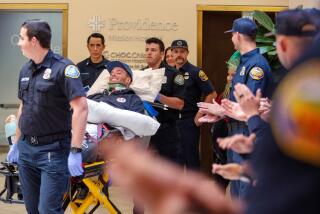Black bear whose paws were scorched in North Complex fire returned to wilderness
A 10-year-old black bear burned in the North Complex fire has been released back into the wild after an innovative treatment helped heal his scorched feet, wildlife veterinarians said.
Officials with the California Department of Fish and Wildlife found the 370-pound bear in mid-September near the town of Berry Creek in Butte County, where the North Complex blaze has burned more than 318,000 acres since igniting Aug. 18. All four of the animalâs paw pads had been burned and he was unable to walk on his own.
After tranquilizing the bear, officials transported him to the Wildlife Investigations Laboratory in Rancho Cordova, where he was evaluated by Fish and Wildlife veterinarians Deana Clifford and Emma Lantz. His lungs were damaged from smoke inhalation, his paws were badly burned and he had a minor eye injury.
Paw pad injuries are common for animals in wildfires, Clifford said, noting that when the tender tissue is damaged, it can present significant problems.
âThatâs the challenge,â she said. âIf they canât walk, they canât find water and they canât find prey. ... They become stuck.â
The bearâs rescue was the result of a partnership between the California Department of Fish and Wildlife and the UC Davis School of Veterinary Medicine, which banded together in the midst of Californiaâs worst-ever wildfire season to find and treat animals injured by flames. Dubbed the Wildfire Disaster Network, the group comprises veterinarians, wildlife biologists, ecologists, trained animal care volunteers and rehabilitation centers.
Firefighters found the tiny orange tabby with ginormous ears covered in soot and ash on a road near Berry Creek.
Under the direction of Jamie Peyton, the chief of service at UC Davisâ Veterinary Medical Teaching Hospital, the bear was given a suite of treatments, including pain medication, fluids, infrared lasers and anti-inflammatory salve. The animal also received an innovative treatment involving the use of tilapia skins as natural bandages for its paw pads.
Afterward, he was kept in a quiet enclosure for several days and monitored around-the-clock with a remote camera. The bearâs appetite remained healthy throughout recovery, and he even put on weight, but officials were eager to take him home.
âThese are free-ranging animals that have never been in a cage,â Clifford said, âand so this is not an ideal situation for them. What is ideal is for us to get them back in the wild.â
The baby, who is about 4 to 6 weeks old and was dubbed Capt. Cal, is recovering at the Oakland Zoo.
On Oct. 5, staff deemed the bear ready for release, and wildlife biologist Henry Lomeli transported him back to Butte County. Lomeli chose a site within 25 miles of his home range but safe from the wildfireâs path.
The bear quickly ran back into the wilderness and even managed to pull off his tracking collar along the way.
He was the first of several animal patients this year. The Wildfire Disaster Network is now treating a female mountain lion from the Bobcat fire in Los Angles County that arrived on Sept. 21, and a 520-pound bear from the Zogg fire in Shasta County that arrived Sept. 30.
âItâs likely that we will receive more wildlife with burns,â Clifford said. âWe are only halfway through the regular fire season.â
More to Read
Sign up for Essential California
The most important California stories and recommendations in your inbox every morning.
You may occasionally receive promotional content from the Los Angeles Times.











